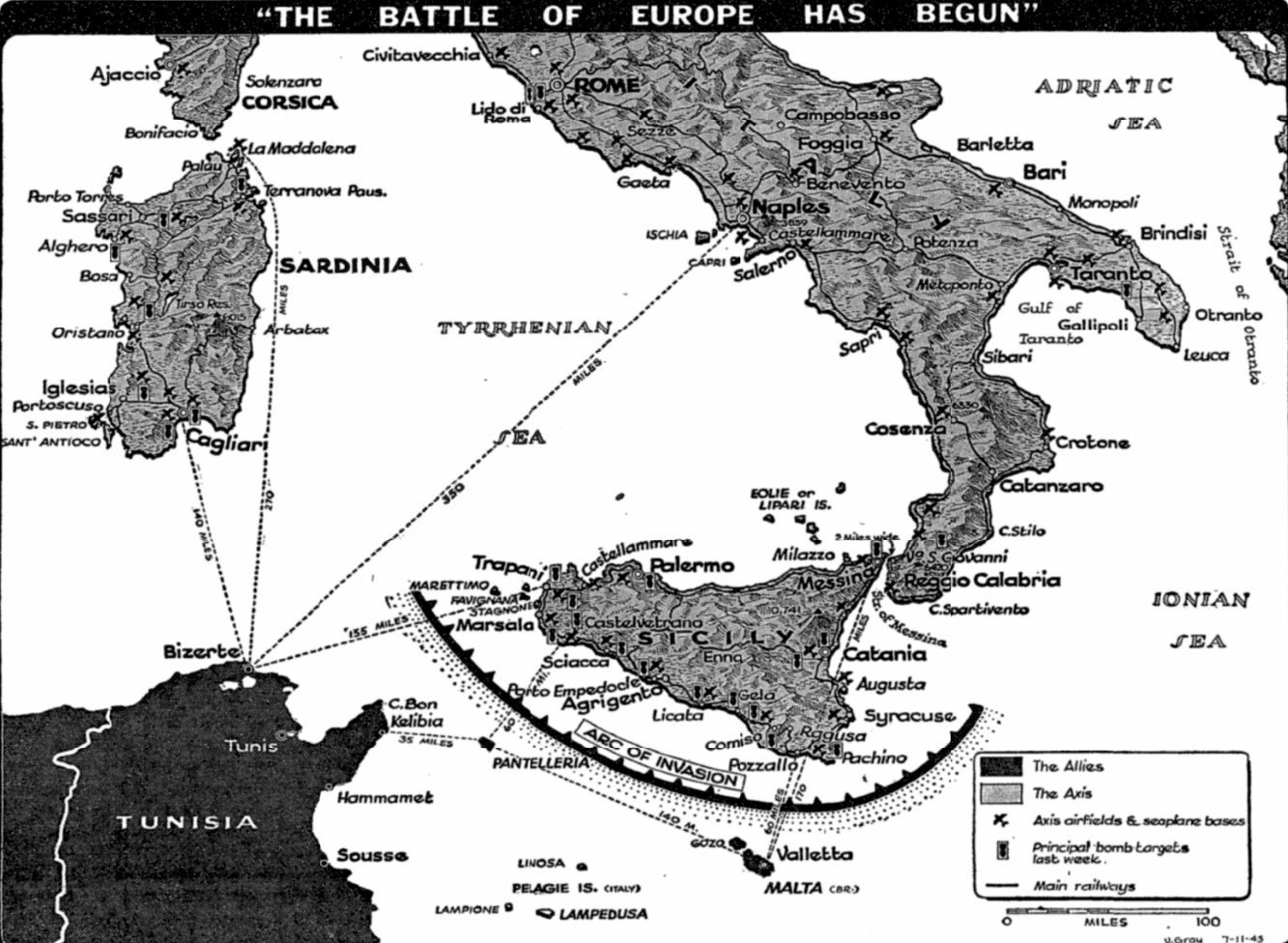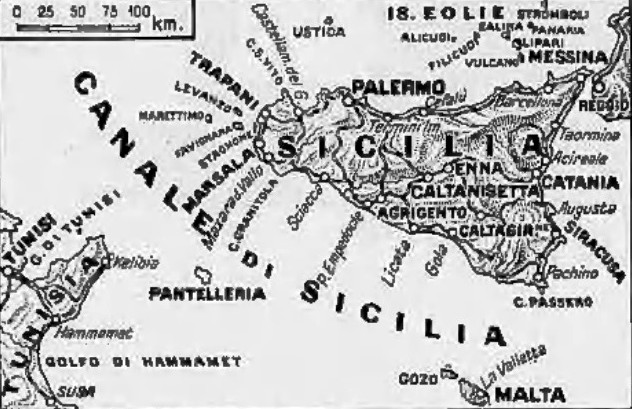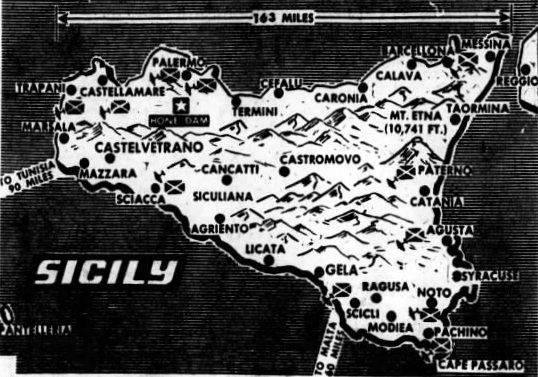A U.S. airdrome, somewhere in Tunisia – (July 10)
A young American reconnaissance pilot came back with the first eyewitness account of the Allied invasion of Sicily today, describing in awed detail a sea black with ships of all sizes and a thunderous bombardment that set leaping flames far inland to protect the landing forces.
2nd Lt. Robert S. Bleile of Seaford, Delaware, said:
Someone was definitely catching hell down there – and I can give you one guess who it was.
Allied warships – battleships, cruisers and destroyers – steamed close to shore, let loose with thundering salvos and then darted back out of range of enemy shore batteries, Lt. Bleile reported. By the time he went over – about 6:20 a.m.-- Lt. Bleile said he could see a chain of smoke and flames extending 10 miles inland.
When he climbed down in fur coat and goggles from his twin-motored Lightning pursuit plane, he had completed only his second operation over enemy territory and was almost breathless from excitement as he told the story of what he had seen.
Around him in the “briefing room” were gathered other pilots waiting to go out on similar missions.
As he removed the cameras with which he took the first invasion pictures – and also one for his personal album – Lt. Bleile said:
I could see a chain of smoke and flame ten miles inland. At sea, I could see Allied warships shelling without interruption. Some warships dashed in close to shore, fired their salvos and then swooped out again. Boy, what a battle picture! I never expect to see anything like it again.
I never saw so many ships in my life. I could distinguish destroyers, like cigars weaving in the cobalt water. I saw bigger ships that looked like battlewagons with wreaths of smoke rising from their turrets. They looked as if they were letting loose with everything they had.
The landing barges looked squirming blackfish. They made a big wake and they seemed to be everywhere – waves of them dashing toward Sicily in relays and others piling in upon the beaches. The barges seemed to be everywhere. As I scanned the sea, over the horizon there seemed to be a never-ending stream of them coming over to help the first waves.
Smoke billows from inland
He was quite a few miles Sicily when he spied the first signs of a great battle – puffs of greyish-white smoke billowing up from the island.
He continued:
It was 6:30 a.m. The sun still was at the far end the island, casting shadows on the beaches. But I soon began to appreciate the tremendous battle waging below as I flew over for 30 minutes. I watched a curtain of our fire searing the coast and inland.
Roaring over the coastline I found no enemy air opposition whatever. I saw what looked like two planes far below, but their attention was being given to the invading forces.
What fascinated me as I coasted along were the antics of the attacking warships. They ran toward shore, pumped shells into the land defenses and then swung away. It was a damned good show.
A picture for the album
He said the smoke which he first saw some miles off shore looked as if it might have come from oil dumps but when he got close to the area, he saw white columns and said he then realized that “everything that could burn was alight.”
At one time he saw a “big blob of warships.”
He said:
That’s when I took one for myself – a picture for my own album. I guess that’s something that will interest the folks back home.
Both Lt. Bleile and Lt. David Fletcher, another American pilot, from Muskegon, Michigan, who came back a short time later, saw Mt. Etna, between Messina and Catania on the east coast, belching smoke but, said Lt. Fletcher:
The real blast furnace was around the landing beaches.
The pictures which both men took were developed and shortly afterward the correspondent had an opportunity to study them. They showed smoke encircling bombarded Sicily with fire spreading as flames licked the parched countryside adjoining the beaches. You could see Allied ships putting down smokescreens and firing their big guns against shore batteries and defense works.
The dramatic pictures showed the struggle raging on the sandy beaches under Sicily’s rocky headlands.
Mt. Etna adds to show
Landing barges were scattered along the shores while others, having stormed through a red curtain of fire from costal batteries, could be seen turning back to sea. Groups of destroyers were shown escorting troop transports.
Masses of barges were visible pounding through the sea toward the beaches, surrounded by puffs of shell bursts. The sea was churned up like a millrace. One picture showed a pall of smoke from Mt. Etna visible over the battlefield – but nature’s cauldron paled to a faint glow alongside the furnace stoked by the Allied assault weapons.
Pilots see ‘40 miles of boats’
Allied HQ, North Africa –
The invasion of Sicily began with the Allied forces dominating the air. That is clear from tonight’s laconic Communiqué and reports of returning fliers. Heavy and medium bombers and fighters went over by the hundreds and the opposition was negligible.
Returning fliers who had seen the landings came back lyrically enthusiastic. It clearly gave them all the thrill of their lives. It was a mission of B-26 Marauder pilots who went over just before dawn that got one of the best bird’s-eye views.
2nd Lt. N. B. Robbins of Wappinger Falls, New York, said:
It was the biggest thing I ever have seen. I think there were 40 miles of boats of all seizes. On the edges were zig-zagging destroyers and in the middle invasion barges followed by merchant ships.
1st Lt. G. F. Dore of Monson, Maine, saw:
…the whole naval force lined up in battle order over the Mediterranean.
We were just coming home from a raid and they stood out like islands in the sea. Just after we passed they all opened fire and it seemed like a volcanic eruption.
Later this morning, Flying Fortresses struck again and most heavily at the much-bombed Gerbini Airfield near Catania, and on their way back they had a wonderful view of the operations.
Col. Samuel J. Gormly of Alhambra, California, said:
The coastal waters of Sicily were black with invasion barges and supporting naval craft, and all the water between Sicily and Tunisia was full of craft shuttling back and forth as in San Francisco Harbor in the good old days of ferries.
On the way to a strafing mission Lt. Col. Robert C. Paul, of Lake City, Florida, group commander of an A-36 outfit, arrived above the coast just as a number of barges were landing. He saw troops land on the beach and deploy, but while he watched, they met no opposition. He saw no signs of firing but after advancing, “our troops seemed to pause.” At that point, he passed out of their sight.
To a pilot, Capt. Roscoe H. Johnson of Chicago, the invading ground troops looked like “a million fliers going in on the beaches.”
He added:
It was a beautiful sight.
2nd Lt. Donald S. Justier of St. Albans, New York, a bombardier, saw “ships coming in waves and out boys simply pouring on the beaches.”
He said:
It is hard to see how the Italians could do much fighting with so many aircraft in the air.
Our photographic reconnaissance brought back both reports and pictures of Northwest African Air Force fighters literally swarming over southeastern coastal regions of Sicily.
Lt. James J. Armstrong of Muskogee, Oklahoma, was incidentally one of the first to return and he brought back a remarkable series of photographs. The minute he landed, the negatives were rushed to a developing room and in less than an hour, A-36 fighter-bombers had taken off to bomb targets that his photos had revealed. Among other things, there was a 40-car freight train, which got a number of direct hits.


